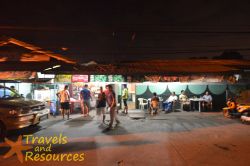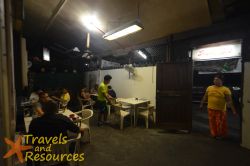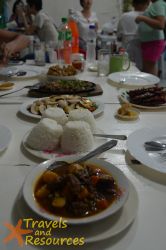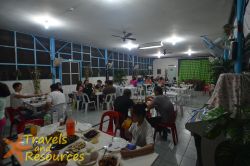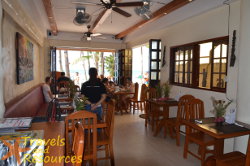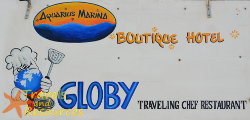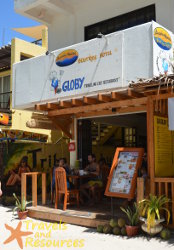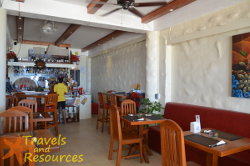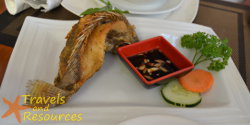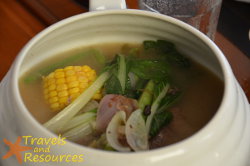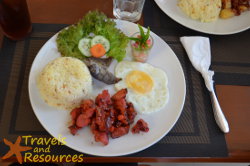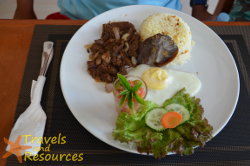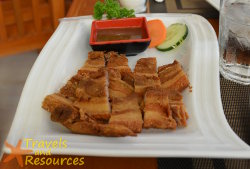CnT Lechon
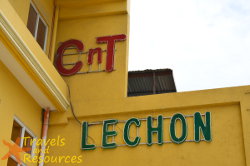
Lunch during our tour of Cebu was at the popular CnT Lechon restaurant. Considered a favorite by locals and tourists alike, we just had to visit this place for its Lechon, or Suckling Pig, for our trip.
Table of Contents
Building
Located on the second floor of a nondescript structure along a road that is undergoing heavy repairs, you’d never know this yellow building housed the famous CnT Lechon. The only thing that gives it away is a set of letters on the second and third floor, something you might miss it if you don’t look up.
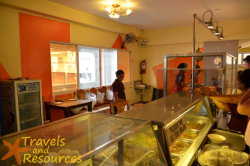
The ground floor is devoted to free covered parking. And as you get down from your vehicle, you’ll find all sorts of from cars to Sport Utility Vehicles to taxi cabs parked between the small posts.
The second floor is accessed through a ramp within the building. The light incline makes it convenient for people with wheelchairs to traverse or for people using a trolley.
If you plan on going to CnT Lechon on your own, don’t worry about getting lost. Chances are any cab you hail will know how to get there. Just mention it before riding in the taxi to make sure he knows where you want to go.
Staff
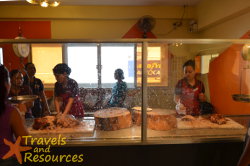
The striking thing about the staff is that it is composed entirely of girls.
Normally restaurants would have a mixture of both guys and girls on their payroll, but this is the only restaurant I have seen so far that has absolutely no men in it.
Even the tough job of chopping and preparing servings of Lechon is done by girls. From behind a protective glass window, you will see two cleavers swinging up and down with a chop-chop-chop-scrape sound.
It is the scraping sound you need to pay attention to because that means that the meat has just been transferred to a serving plate.
Food
Speaking of meat, I’ll cut to the chase on this one. Of all the Lechon places I have eaten at, this restaurant probably serves the juiciest Lechon there is. If fact, you need to be careful when you spear the cubes with your fork or when cutting them with a knife because the juice tends to squirt out at you.
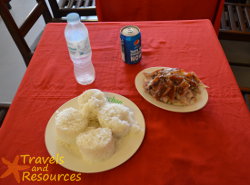
The only drawback of having such a succulent meal is that the balat, or skin, is sometimes not crunchy. We were unfortunate to have gotten a non-crunchy batch. But the people beside us seemed to be happy with their balat.
The lack of crunchy balat hasn’t stopped people from ordering though. When we arrived to get our number at eleven in the morning, we were fifteen people down the queue. And by the time it was twelve in the afternoon, it just about doubled in length.
Other than Lechon, there are other smaller dishes to choose from at the counter. If you want to balance out your meal, you should be able to order a plate or two of vegetables.
The total cost of our meal was a tad under PhP 250. This included a quarter kilo of Lechon, four cups of plain rice, a can of soft drinks, and a bottle of water.
Incidentally, make sure you have lots of napkins because when I say this is one juicy meal, I mean that it is really one juicy meal. By the time you are halfway through your meal, both your utensils and even hands will most likely be full of oil. Not to worry though, as there is a sink and soap near the counter to wash off all that oil.
Condiments
Thanks to the juicy and flavorful meat, pouring Lechon Sauce, or gravy, may be considered a hindrance for some people in enjoying the meal. Other than that, it may be somewhere along the lines of heresy, just like seeing someone pour catsup on Peking Duck.
The accompanying condiment for CnT Lechon is what looks like a mixture of Vinegar, Soy Sauce, and shredded onions, which can be found at the condiment station. It’s an acquired taste so not everyone may like it at first. If find yourself in that group and really can’t do without Lechon Sauce, I noticed a few packs at the counter.
To Go
If you’ll be heading on to the airport right and want to take it with you, you’ve come to the right place. The people behind the counter are so used to packing the Lechon in a box, they can probably do it blindfolded.
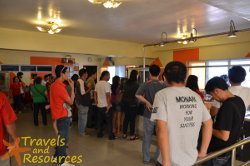
After placing your order and specifying that it be in a box to be brought on the plane all it takes if a few extra minutes to pack everything. It comes in a white box with the CnT logo and is tied with plastic rope to make it easy to hold.
It’s X-ray safe and people at the domestic airports are used to seeing tourists bring home boxes of CnT Lechon, so you shouldn’t have any problems.
I would suggest wiping the box as soon as you get it because the exterior will have oil on it. A couple of table napkins should suffice. Also, don’t forget to wipe the rope too. The last think you’d want is to have your clothes swabbed with oil as you travel on the plane.
Final Thoughts
CnT Lechon serves what is probably the juiciest Lechon there is. The only downside to this is that the balat is sometime not crunchy.
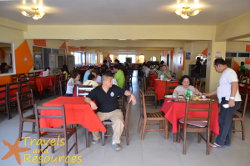
As far as prices go, this was the lowest we paid for in a meal during our entire trip. Not only was it the cheapest, but the serving was the biggest.
And while eating the Lechon as soon as it is chopped is the best way to eat it, taking it home does have its good points.
First of all, you can toast it in an oven to make the balat crunchy. And second, you can eat it with Lechon Sauce without the too much guilt since you can exercise right after. And third, you get to share it with the members of your family who weren’t able to accompany you to Cebu.
Till the next time, keep your appetites up, camera batteries fully charged, and your memory free because you may need them for the next place you visit!

